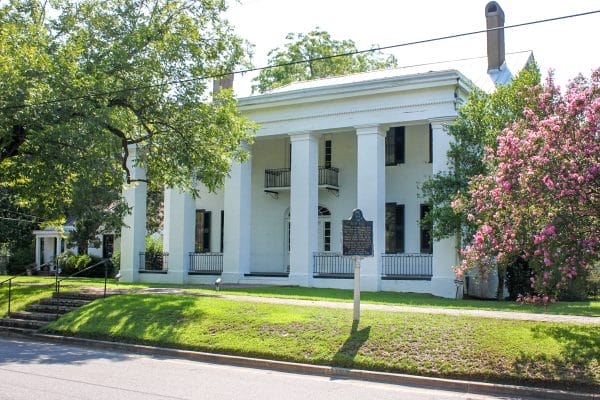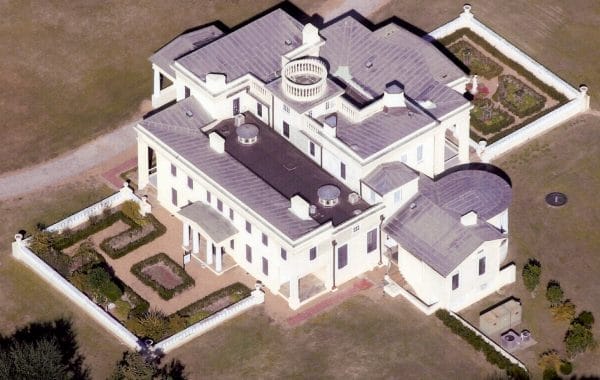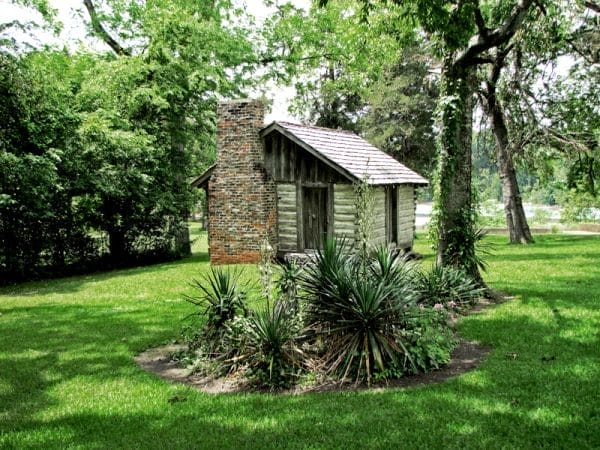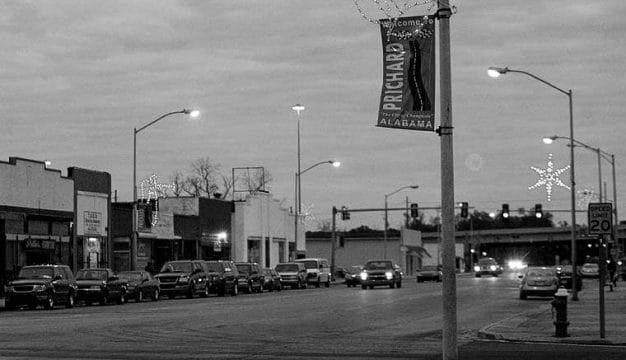Bluff Hall
Bluff Hall in Demopolis, Marengo County, is a house museum and popular Alabama tourist attraction. Dating from the 1830s, it showcases nineteenth and early twentieth century antiques and furniture along with an extensive clothing and textiles collection. Bluff Hall is considered one of Alabama’s most impressive Greek Revival river mansions.
 Bluff Hall
Bluff Hall was built in 1832 by Allan Glover, already a merchant and wealthy plantation owner when he arrived in Demopolis in 1819. He then became a business partner of Indian factor George Strother Gaines and is reported to have bought up land from members of the Vine and Olive Colony. There is speculation surrounding the reasons for building the house. Most historians believe it was a wedding gift from Allan Glover to his daughter Sarah Serena Glover and her husband Francis Strother Lyon, who was a cotton plantation owner, lawyer, and future statesman. Others, however, suggest it may have been an anniversary gift for Glover’s daughter. These claims are based on the fact that Sarah and her husband lived with her father, who was a widower, at Glover’s house on Capital Street until he remarried. Once Glover remarried, Sarah and Francis were allowed to move out.
Bluff Hall
Bluff Hall was built in 1832 by Allan Glover, already a merchant and wealthy plantation owner when he arrived in Demopolis in 1819. He then became a business partner of Indian factor George Strother Gaines and is reported to have bought up land from members of the Vine and Olive Colony. There is speculation surrounding the reasons for building the house. Most historians believe it was a wedding gift from Allan Glover to his daughter Sarah Serena Glover and her husband Francis Strother Lyon, who was a cotton plantation owner, lawyer, and future statesman. Others, however, suggest it may have been an anniversary gift for Glover’s daughter. These claims are based on the fact that Sarah and her husband lived with her father, who was a widower, at Glover’s house on Capital Street until he remarried. Once Glover remarried, Sarah and Francis were allowed to move out.
The house remained in the Lyon family until 1907, when it was purchased by A. R. Smith. The Smith family maintained the residence until the 1940s and divided it into rental apartments. The Marengo County Historical Society (founded in 1961) purchased the home in March 1967 with the intention of converting it into a historic house museum.
The location of the home is near the landing site of French expatriates who, in 1817 established the Vine and Olive Colony around present-day Demopolis. The physical location is called White Bluff for the limestone cliff upon which the home sits overlooking the Tombigbee River, one of the major rivers comprising the Mobile River Basin.
 Gaineswood Aerial View
Surveys conducted by the Historic American Buildings Survey (HABS) in 1936 and the National Register of Historic Places (NRHP) in 1970 detail and document the home’s construction and architectural history. At the time of the 1970 NRHP survey, efforts were being made to restore the home to so that it could be used as a period house and local museum. The data that existed regarding the home’s architectural history helped restoration efforts maintain a historically accurate physical appearance. With the exception of the roof that was originally covered with wooden shingles, the exterior of the house had not been altered.
Gaineswood Aerial View
Surveys conducted by the Historic American Buildings Survey (HABS) in 1936 and the National Register of Historic Places (NRHP) in 1970 detail and document the home’s construction and architectural history. At the time of the 1970 NRHP survey, efforts were being made to restore the home to so that it could be used as a period house and local museum. The data that existed regarding the home’s architectural history helped restoration efforts maintain a historically accurate physical appearance. With the exception of the roof that was originally covered with wooden shingles, the exterior of the house had not been altered.
The initial stages of the house were constructed in 1832 by enslaved African American labor, forming the L-shaped section of the house that faces east. The original portico of the home was designed in the Federal style. The second phase, which occurred in the late 1840s, added a west wing and a new two-story portico with six square columns in the Greek Revival style. This formed the present layout of house. Part of this addition also included a dining room, butler’s pantry, two bedrooms, and the kitchen. There was a one-foot-thick firewall separating the kitchen from the rest of the house. The home’s cellar was built by enslaved African American Peter Lee, a craftsman who later bought his freedom with income from outside work, according to a historical society official.
A combination of materials was used in the home’s construction. The exterior and interior walls are brick, with the exterior being covered in plaster and painted white. The bricks used were baked in kilns on the home’s grounds. The columns are covered with plaster and form the façade of the home. The north half of the rear west wing is made of lumber, with overlapping boards, that was felled and hewn by slave labor.
The main ornamental features of the interior are the Corinthian columns located in the drawing room. The dining room also has elaborate crown molding with a border of grapes and grape leaves at the top of the ceiling. The marble mantles in the dining room are made of Italian black marble. The kitchen contains a large fireplace, with a double flue. Gates, fencing, and outbuildings, including a carriage house and outhouse, have been removed over the years, though some foundations had been visible.
 Bluff Hall Log Cabin
Significant alterations to the interior structure of the home were required because it had been used as an apartment building. Therefore, it was necessary to remove all plumbing, plaster the walls, take up the downstairs floors, install new sills and supports, and refinish all the floors. This was a collective effort made possible by contributions from MCHS members, citizens of Demopolis, and Lyon family descendants. As of January 2018, the MCHS had returned about 75 percent of the authentic furnishings to Bluff Hall.
Bluff Hall Log Cabin
Significant alterations to the interior structure of the home were required because it had been used as an apartment building. Therefore, it was necessary to remove all plumbing, plaster the walls, take up the downstairs floors, install new sills and supports, and refinish all the floors. This was a collective effort made possible by contributions from MCHS members, citizens of Demopolis, and Lyon family descendants. As of January 2018, the MCHS had returned about 75 percent of the authentic furnishings to Bluff Hall.
A log cabin that sits on the property was found within the walls of a local Victorian-era home during its demolition. The historical society dated the cabin to the original French expatriates, and combined efforts both saved the cabin and moved it to the grounds of Bluff Hall. Architectural historians with the HABS noted that Bluff Hall once stood on a large amount of acreage but now sits closely to a paved street.
Bluff Hall is located at 407 North Commissioners Avenue. It is open Tuesday through Saturday from 10:00 a.m. to 5:00 p.m. and on Sundays from 2:00 p.m. to 5:00 p.m. There is an admission fee. Nearby in Demopolis are Laird Cottage as well as Lyon Hall and Gaineswood, two other noted antebellum plantation houses.


